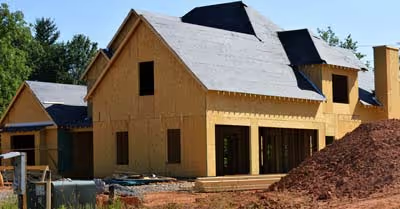Table of Contents
The Difference Between Land Loans and Traditional Mortgages
One of the main reasons getting undeveloped land financed is so much different than getting developed land financed is the risk it poses to the lender. This is for a multitude of reasons, including both how easy it would be to sell the land should the buyer default and the amount of value the buyer bestows upon the property, the latter determining their chances of paying their loan. Both of these can be greatly reduced by both the amount of development that has occurred on a given plot of land and the amount of development that has occurred around a given plot of land.
Undeveloped Land Poses a Greater Financial Risk for Lenders
Of course, the likelihood of a lender financing land will be determined by how risky the lender determines said loan to be. In many cases, a vacant lot of land is much harder to sell than a lot of land that has been developed on and already exists within an established commercial or residential area. Land that exists in an area that is largely undeveloped does not pose an interest to most commercial buyers. Therefore, the likelihood of said land being easy to flip should the buyer choose to default on their loan is often low for land with no developed properties.
As well, if a land has no resources or developments on it, the buyer is unlikely to feel tied to the land. If the land is simply a vacant lot, the buyer could easily choose to abandon the plot of land without sacrificing much. It could be that the buyer purchased the land intending to build their own structure on it and then found out that the land was not capable of supporting the structure they intended. In this case, the buyer could choose to cut their losses, leaving the lender to sport the bill for the property.
For these reasons, banks and other financial institutions are often less likely to put faith in buyers of vacant plots of land. However, should the buyer put a plan in place to develop the land and have the land surveyed to show that developments will be able to take place, financing might be able to be worked out. This will require some work on the part of the buyer, but it may be worth it in procuring financing for your vacant lot of land.
The Difference Between Improved Land and Unimproved Land
Given the above, one of the main things that a bank or other financial institution will look at in determining the risk or reward in regards to offering financing on a given plot of land is whether that land is considered "improved land" or "unimproved land". Improved land, whether it is specifically developed on or not, will have easy access to some benefits of developed society, such as electricity, running waters, and roads, whether dirt or paved. Unimproved land, on the other hand, will simply be raw land that is neither developed on nor developed around.
Regardless of what the buyer's plans for the land are, improved land is going to pose less of a risk to the lender in the event that the buyer should choose to default on the land for any reason. As well, improved land is ideal land for creating your own developments, as houses can be sure to have running water and electricity while businesses can be sure to have at least some amount of through-traffic.
Securing Financing on Unimproved Land
Financing unimproved land is not an impossible feat, but it may require both an increased down payment, greater interest, and more stringent terms for financing. In many cases, a buyer may wish to procure unimproved land as an investment. Due to the increased percentages they may end up having to pay back to the bank, this may seem like not too prosperous of a prospect. Still, if you would like to have your own lot of land, possibly for camping on or even building your own off-the-grid tiny home or log cabin, it is typically going to be doable. If you are looking at buying unimproved land as an investment, you may look towards areas with unimproved land that has been increasing in value in recent years.
Land With Recently Increased Value Holds Less Financial Risk
A definite factor in the ability to get financing through a bank or other financial institution would be how much the value of said land has been increasing in recent years. If property values are going up in the area you wish to purchase land, that land will prove less of a risk to lenders, regardless of what you intend to do with it. However, this also means that you will need to strike fast if you wish to get the land before prices become too exuberant. This would also be the perfect opportunity for those who wish to procure undeveloped land as an investment.
Procuring Construction Loans
If you intend to build a residence on a given plot of land, there are some loans, known as "construction loans", that banks and other financial institutions may offer for financing both the land and the construction. Eventually, the loan will bleed over into you paying off the established home and property. There are two different types of construction loans, "construction-to-permanent loans" and "stand-alone constructions loans". Construction-to-permanent loans are more inclusive and require less steps from the buyer.
The benefit of a construction loan is that it will pay for both the land and the construction, meaning you don't have to worry about doing everything quite as separately. This can save you both time and money. Construction-to-permanent loans are even more beneficial to the buyer than stand-alone construction loans as they require fewer steps. Stand-alone construction loans will require two separate closings, one on the land on one on the house, whereas with construction-to-permanent loans, both loans are wrapped together into one agreement.
With construction loans, the land will need to be properly zoned and surveyed for either residency or commercial operation before the loan goes through. However, the fact that there is still no 100% guarantee for the lender that the development will occur without a hitch means that construction loans still pose a slightly higher risk to banks and other financial institutions than traditional mortgages on developed land. For that reason, construction loans may have slightly higher interest rates than traditional mortgages, though they will still usually be less than the rates for financing a plot of land that you do not intend to develop on.
Equity and Seller Financing
There are a few other options besides the buyer having to directly finance the land through a bank or other financial institution personally that may present themselves if you don't have enough funds in the bank to purchase the land outright. For one thing, you may be able to take out another mortgage on property you already own, such as a home or business, and use that money as a means to pay the full purchase price for the given lot of land. As well, the seller may go through the financing process for you, essentially becoming your lender themselves.
In both these cases, the buyer may be at a slight disadvantage compared to if they were to go directly through the banks for financing themselves. However, they also each pose some unique benefits to the buyer. The drawbacks for taking out another mortgage would be that you are putting risk on property you already own, while the positive would be that you aren't having to finagle direct financing of the land through the bank. The drawbacks for the seller financing the land for you would be that the seller then can charge you exuberant interest rates, being allowed to set the terms to their own personal discretion.
Buying Developed Land for Demolition
Lastly, let's take a look at the process of buying land with a development already on it with the intention of demolishing the development and starting from scratch. Depending on the state of the current development, securing a loan in these instances is often more practical than securing a loan on land that is outright vacant. However, this process does come with the cost of demolishing the current development and therefore might not be practical for all buyers.
If you're buying land that is already developed with the intention of demolishing said development, there is also a strong likelihood that there are other, similar developments in the vicinity. In these cases, there might be some added trouble when it comes to creating any new developments in the wake of old ones. Many neighborhoods and other communities don't take kindly to new developments that don't fit into the established aesthetic of the area. There could be municipal codes put in places severely limiting your options as far as any new developments on the land, which should also be taken into consideration before deciding to go this route.
Recent Articles











